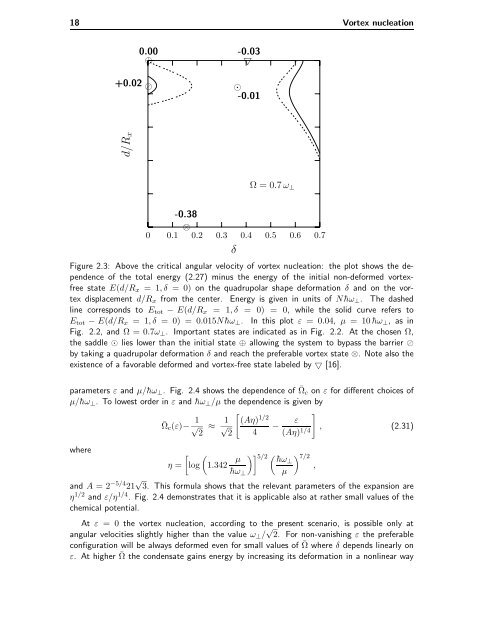Bose-Einstein Condensates in Rotating Traps and Optical ... - BEC
Bose-Einstein Condensates in Rotating Traps and Optical ... - BEC
Bose-Einstein Condensates in Rotating Traps and Optical ... - BEC
You also want an ePaper? Increase the reach of your titles
YUMPU automatically turns print PDFs into web optimized ePapers that Google loves.
18 Vortex nucleation<br />
0.00<br />
⊕<br />
+0.02 ⊘<br />
d/Rx<br />
0<br />
-0.38<br />
⊗<br />
0.1 0.2<br />
0.3<br />
-0.03<br />
▽<br />
⊙<br />
-0.01<br />
δ<br />
0.4<br />
Ω=0.7 ω⊥<br />
Figure 2.3: Above the critical angular velocity of vortex nucleation: the plot shows the dependence<br />
of the total energy (2.27) m<strong>in</strong>us the energy of the <strong>in</strong>itial non-deformed vortexfree<br />
state E(d/Rx =1,δ =0)on the quadrupolar shape deformation δ <strong>and</strong> on the vortex<br />
displacement d/Rx from the center. Energy is given <strong>in</strong> units of N¯hω⊥. The dashed<br />
l<strong>in</strong>e corresponds to Etot − E(d/Rx = 1,δ = 0) = 0, while the solid curve refers to<br />
Etot − E(d/Rx = 1,δ = 0) = 0.015N¯hω⊥. In this plot ε = 0.04, µ = 10¯hω⊥, as <strong>in</strong><br />
Fig. 2.2, <strong>and</strong> Ω=0.7ω⊥. Important states are <strong>in</strong>dicated as <strong>in</strong> Fig. 2.2. At the chosen Ω,<br />
the saddle ⊙ lies lower than the <strong>in</strong>itial state ⊕ allow<strong>in</strong>g the system to bypass the barrier ⊘<br />
by tak<strong>in</strong>g a quadrupolar deformation δ <strong>and</strong> reach the preferable vortex state ⊗. Notealsothe<br />
existence of a favorable deformed <strong>and</strong> vortex-free state labeled by ▽ [16].<br />
parameters ε <strong>and</strong> µ/¯hω⊥. Fig. 2.4 shows the dependence of ¯ Ωc on ε for different choices of<br />
µ/¯hω⊥. To lowest order <strong>in</strong> ε <strong>and</strong> ¯hω⊥/µ the dependence is given by<br />
¯Ωc(ε)− 1<br />
√ ≈<br />
2 1<br />
<br />
(Aη) 1/2 ε<br />
√ −<br />
2 4 (Aη) 1/4<br />
<br />
, (2.31)<br />
where<br />
<br />
η = log 1.342 µ<br />
5/2 7/2 ¯hω⊥<br />
,<br />
¯hω⊥ µ<br />
<strong>and</strong> A =2−5/421 √ 3. This formula shows that the relevant parameters of the expansion are<br />
η1/2 <strong>and</strong> ε/η1/4 . Fig. 2.4 demonstrates that it is applicable also at rather small values of the<br />
chemical potential.<br />
At ε = 0 the vortex nucleation, accord<strong>in</strong>g to the present scenario, is possible only at<br />
angular velocities slightly higher than the value ω⊥/ √ 2. For non-vanish<strong>in</strong>g ε the preferable<br />
configuration will be always deformed even for small values of ¯ Ω where δ depends l<strong>in</strong>early on<br />
ε. At higher ¯ Ω the condensate ga<strong>in</strong>s energy by <strong>in</strong>creas<strong>in</strong>g its deformation <strong>in</strong> a nonl<strong>in</strong>ear way<br />
0.5<br />
0.6<br />
0.7




